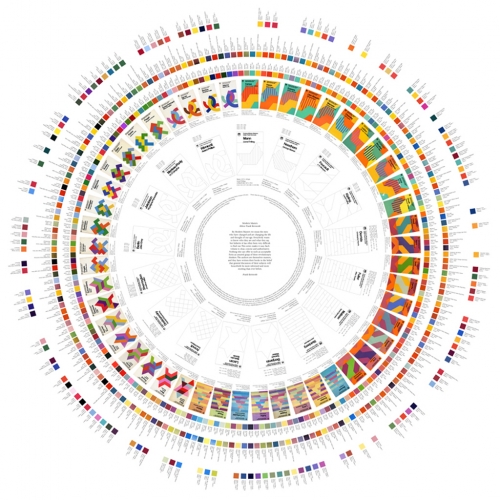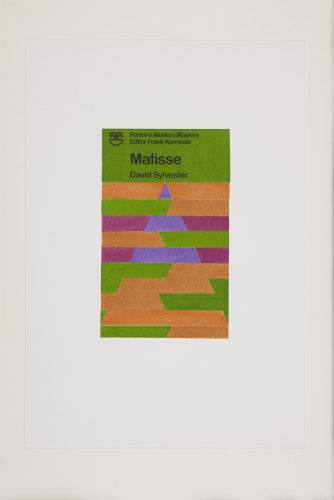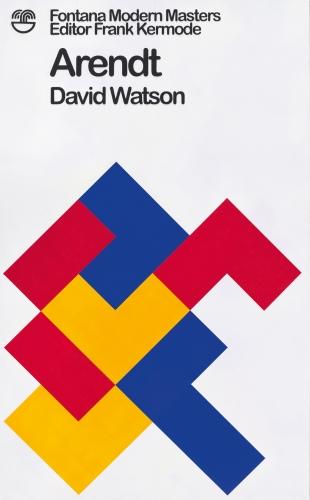I come not to praise Jamie but to Shovl'im… Jamie Shovlin's new show of covers for unpublished books in the Fontana Modern Masters series would seem to have everything for the viewer who prides himself on his good taste: serialism, mathematics, intellectuals, paint applied by the artist himself. The shame is that it's all a hoax, and not in the manner of Shovlin's earlier projects concerned with fictional people: the maths is cod, the belief absent - even the pauses for thought are artificial.
The original covers of the Fontana series are distinctive - Vasarely-ish geometrical designs in the ugliest colours the Seventies had to offer. There's a pleasing rhythmical dissonance to them, like they're meant to jar the eye. That's only fitting given their subjects. The most dissonant artists, writers and thinkers of the 20th-century, and the charm for other artists is evident.
Shovlin had earlier shown at Riflemaker with a first set of interpretations of what the "missing" covers might look like, with colours and patterns chosen according to points assigned by a fairly arbitrary scoring system, ranking this philosopher better than that painter. For some reason, he has chosen to revisit this project.
 The first work you see is a massive chart (pictured left), with Frank Kermode's mission statement at its heart and concentric circles giving the rules for scoring (did the author win a Nobel Prize? How many pages are there in his collected books?) and analysis of the colours used on existing covers, which is then refined into 16 colours for use on the new covers. The main body of the exhibition are these devised covers, two metres high, painted in acrylic.
The first work you see is a massive chart (pictured left), with Frank Kermode's mission statement at its heart and concentric circles giving the rules for scoring (did the author win a Nobel Prize? How many pages are there in his collected books?) and analysis of the colours used on existing covers, which is then refined into 16 colours for use on the new covers. The main body of the exhibition are these devised covers, two metres high, painted in acrylic.
So yes, it's very clever-clever. Shovlin has rated and ranked intellectuals by spurious criteria and then created paintings to say that you can and cannot judge a book by its cover.
The problem is that it's all so false. Shovlin has built the covers up in layers, each stratum another potential cover, so that you can see what might have been through what is. This is grasping at the potential of a palimpsest, but palimpsests reveal something interesting, forbidden or hidden, not another stage in a deliberately arbitrary process. I certainly cannot believe that the Arendt cover, with its suggestion of the swastika, was accidentally chosen. This touch feels conceited, self-satisfied.
On a work in the first room, the colours of each existing cover are analysed; there are question marks and gaps in his notes, to imply thought or hesitation, but I don't believe that Shovlin was at all hesitant - or thoughtful. It all feels mannered - every gesture is exactly the gesture one would make if one were passionately involved in a project, yet Shovlin is going through the motions.
 The pieces in which Shovlin comes nearest to something real are the small watercolours of his new covers (pictured right), which are beautiful and careful and have a human touch - they are not grandiose exercises of the intellect as the paintings are but delicate and appropriate for the series.
The pieces in which Shovlin comes nearest to something real are the small watercolours of his new covers (pictured right), which are beautiful and careful and have a human touch - they are not grandiose exercises of the intellect as the paintings are but delicate and appropriate for the series.
Bearing in mind Shovlin's love of devising a fictional past, it would not surprise me if he had made up the Riflemaker show or Fontana Modern Masters or even the entire career of Frank Kermode just to serve present purposes and to fool us all once again. The problem with Shovlin is that you can't trust him.
- Jamie Shovlin: Various Arrangements at Haunch of Venison, 103 New Bond Street, until 26 May 2012









![SEX MONEY RACE RELIGION [2016] by Gilbert and George. Installation shot of Gilbert & George 21ST CENTURY PICTURES Hayward Gallery](/sites/default/files/styles/thumbnail_125_x_125_/public/mastimages/Gilbert%20%26%20George_%2021ST%20CENTURY%20PICTURES.%20SEX%20MONEY%20RACE%20RELIGION%20%5B2016%5D.%20Photo_%20Mark%20Blower.%20Courtesy%20of%20the%20Gilbert%20%26%20George%20and%20the%20Hayward%20Gallery._0.jpg?itok=3oW-Y84i)





Add comment